
P0150 Oxygen sensor circuit malfunction (sensor 1, bank 2)
Content
P0150 – OBD-II Trouble Code Technical Description
Trouble code P0150 indicates a malfunction in the oxygen sensor 1 (bank 2) circuit.
What does the fault code mean P0150?
Trouble code P0150 indicates a problem with the Oxygen Sensor on circuit 2, bank 2. This usually means that the oxygen sensor located on the second exhaust manifold (bank 2) of the engine is not functioning correctly or has failed. The oxygen sensor measures the level of oxygen in the exhaust gases and transmits this information to the engine control module (ECM), which adjusts the fuel-air mixture to ensure optimal engine performance and reduced emissions.

Possible reasons
Possible reasons for DTC P0150:
- Defective oxygen sensor: The oxygen sensor may be faulty, causing the exhaust gas oxygen levels to be incorrectly read.
- Damage to the wiring or connector of the oxygen sensor: The wiring or connector connecting the oxygen sensor to the engine control module may be damaged or have poor contact.
- Problems with power or grounding of the oxygen sensor: Improper power supply or grounding may cause the oxygen sensor to not function properly.
- Problems with the engine control module (ECM): Faults in the engine control module can lead to incorrect processing of signals from the oxygen sensor.
- Problems with the exhaust system: Improper operation of the exhaust system, such as leaks or damage, may affect the performance of the oxygen sensor.
What are the symptoms of a fault code? P0150?
Some of the possible symptoms that may accompany the P0150 code include:
- Increased fuel consumption: A faulty oxygen sensor can cause the engine management system to malfunction, which can increase fuel consumption.
- Loss of power: A faulty oxygen sensor can result in a suboptimal fuel/air mixture, which can reduce engine performance and cause loss of power.
- Unstable idle: A faulty oxygen sensor can result in a rough idle or even a misfire.
- Increased emissions of harmful substances: A faulty oxygen sensor can result in an incorrect fuel/air mixture, which can increase exhaust emissions of harmful substances such as nitrogen oxides (NOx) and hydrocarbons (HC).
- Black smoke from the exhaust system: Improper fuel and air mixture may cause excessive fuel delivery and black smoke.
- Errors on the dashboard (Check Engine Light): One of the most obvious symptoms will be the appearance of an error on the dashboard indicating a problem with the oxygen sensor.
- Unstable engine operation on a cold start: During cold engine starts, a faulty oxygen sensor can cause problems with initial idle speed and engine stability.
It is important to note that not all symptoms will necessarily occur at the same time or at the same time as the P0150 code appears. If you suspect an issue with your oxygen sensor or trouble code P0150, it is recommended that you have your vehicle diagnosed and repaired by a qualified mechanic.
How to diagnose a fault code P0150?
Diagnosing the P0150 trouble code involves several steps to determine the specific cause of the error, a general set of actions that can be taken:
- Scanning error codes: Use a diagnostic scanner to read error codes from the engine control module. Verify that the P0150 code is present and make a note of other possible error codes that may aid diagnosis.
- Checking the oxygen sensor (O2 Sensor): Disconnect the oxygen sensor from the exhaust system and use a multimeter to check its resistance or voltage. Make sure the values are within the manufacturer's specifications.
- Checking wiring and connections: Check the condition of the wiring and connectors connecting the oxygen sensor to the engine control module. Pay attention to the presence of corrosion, breaks or distortions.
- Checking power and grounding: Make sure the oxygen sensor is receiving proper power and ground. Check the voltage on the corresponding contacts.
- Checking engine operation: Assess the engine's performance under various operating conditions such as idle, load, etc. Note any anomalies in operation that may indicate fuel/air mixture problems.
- Additional tests and inspections: Depending on the results of the above steps, additional diagnostics may be required, such as checking the condition of the exhaust system, fuel injection system, and other engine management system components.
After diagnosing and determining the specific cause of the P0150 code, it is recommended to carry out the necessary repairs or replace the faulty components. If you are unsure of your skills or experience, it is best to have your vehicle diagnosed and repaired by a qualified mechanic or authorized service center.
Diagnostic errors
When diagnosing the P0150 trouble code, several errors may occur that can make it difficult or misinterpret the problem:
- Ignoring other error codes: Sometimes other error codes can accompany the P0150 code and indicate additional problems in the system. Ignoring these additional codes may result in missing important information.
- Incorrect interpretation of diagnostic results: Incorrect interpretation of diagnostic results may lead to the problem being misdiagnosed. For example, poor oxygen sensor test results may be caused by wiring or connection problems.
- Replacing components without sufficient diagnostics: Sometimes mechanics may immediately assume that the problem is with the oxygen sensor and proceed to replace it, ignoring other possible causes, such as problems with the wiring or engine control module.
- Incorrect repair or replacement of components: Carrying out incorrect repairs or replacing components that do not address the actual cause of the problem can lead to further problems and repair costs.
- Insufficient diagnosis: Not performing a complete diagnostic may result in missing important steps such as checking wiring, connections, and other engine management system components.
To avoid these mistakes, it is important to follow professional diagnostic techniques, use the correct equipment, perform tests in accordance with the manufacturer's recommendations and, if necessary, contact an experienced technician for help and advice.
How serious is the fault code? P0150?
Trouble code P0150 indicates a problem with the Oxygen Sensor on circuit 2, bank 2. The severity of this problem can vary depending on the specific cause and vehicle operating conditions. Here are several aspects that determine the severity of the P0150 code:
- Impact on emissions: A malfunctioning oxygen sensor can result in an incorrect mixture of fuel and air, which in turn can increase emissions of harmful substances in the exhaust gases. This can lead to emissions problems and non-compliance with environmental regulations.
- Loss of power and efficiency: Improper operation of the oxygen sensor can result in suboptimal engine performance, which can result in loss of power and increased fuel consumption.
- Influence on engine performance: Incorrect operation of the oxygen sensor can affect engine performance, including engine stability and smoothness. This can lead to rough idling and other problems.
- Possibility of catalytic converter damage: Continued operation with a faulty oxygen sensor may cause damage to the catalytic converter due to improper fuel/air mixture or excess fuel in the exhaust gases.
- Unpredictability of vehicle performance: A malfunctioning oxygen sensor can cause various abnormalities in the vehicle's performance, which can make it less predictable and controllable.
Based on the above factors, the P0150 trouble code should be considered a serious issue that can affect the safety, performance, and reliability of your vehicle. Therefore, it is recommended to carry out diagnosis and repair as soon as possible to avoid further problems.
What repair will help eliminate the code? P0150?
Resolving the P0150 trouble code may vary depending on the specific cause of the problem, some possible steps that may help resolve this issue are:
- Replacing the oxygen sensor: If the oxygen sensor is truly faulty or has failed, replacing it with a new, working one may be enough to resolve the P0150 code. Make sure the oxygen sensor you are replacing is of the correct specifications for your specific vehicle.
- Checking and replacing wiring and connectors: Check the condition of the wiring, connections and connectors associated with the oxygen sensor. Poor connections or breaks can cause the P0150 code. If necessary, replace damaged wires or connectors.
- Checking power and grounding: Make sure the oxygen sensor is receiving proper power and ground. Check the voltage on the corresponding contacts.
- Engine Control Module (ECM) Diagnostics and Repair: In some cases, the problem may be due to a faulty engine control module. In this case, the ECM may need to be diagnosed and, if necessary, repaired or replaced.
- Checking the exhaust system and fuel injection system: Malfunctions in the exhaust system or fuel injection system can also cause P0150. Check the condition of these systems and make any necessary repairs or replacements.
- Updating the software: Sometimes the problem can be solved by updating the engine control module software.
It is important to conduct a detailed diagnosis to determine the specific cause of the P0150 code before performing any repair work. If you are unsure of your skills or experience, it is recommended that you have your vehicle diagnosed and repaired by a qualified mechanic or authorized service center.
P0150 – Brand-specific information
Trouble code P0150 indicates a problem with the Oxygen Sensor on circuit 2, bank 2. The meaning of this code may vary slightly depending on the specific vehicle manufacturer. Here are some decodings for various car brands:
- Volkswagen (VW): P0150 means “O2 Sensor Circuit Malfunction (Bank 2, Sensor 1)”.
- Ford: P0150 means “Oxygen Sensor Circuit Malfunction (Bank 2, Sensor 1)”.
- Chevrolet / GMC: P0150 means “Oxygen Sensor Circuit Malfunction (Bank 2, Sensor 1)”.
- Toyota: P0150 means “Oxygen Sensor Circuit Malfunction (Bank 2, Sensor 1)”.
- BMW: P0150 means “Oxygen Sensor Circuit Range/Performance Problem (Bank 2 Sensor 1)”.
- Mercedes-Benz: P0150 means “Oxygen Sensor Circuit Malfunction (Bank 2, Sensor 1)”.
- Audi: P0150 means “O2 Sensor Circuit Malfunction (Bank 2, Sensor 1)”.
- Honda: P0150 means “Oxygen Sensor Circuit Malfunction (Bank 2, Sensor 1)”.
- Hyundai: P0150 means “Oxygen Sensor Circuit Malfunction (Bank 2, Sensor 1)”.
- Nissan: P0150 means “Oxygen Sensor Circuit Malfunction (Bank 2, Sensor 1)”.
Please note that these transcripts may vary slightly depending on the model and year of manufacture of the vehicle. If you are having problems with the P0150 code, it is recommended that you consult the repair manual for your specific vehicle model or contact an authorized service center for more detailed information.

